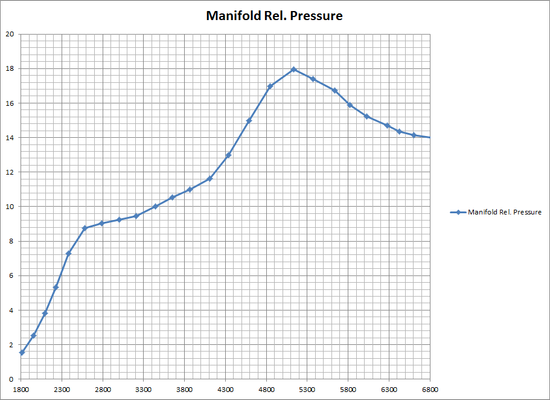GR Boost Creep
"Boost creep is a condition of rising boost levels past what the predetermined level has been set at. Boost creep is caused by a fully opened Wastegate(s) not being able to flow enough exhaust to bypass the housing via the Wastegate(s) itself. For example, if your boost is set to 12psi, and you go into full boost, you will see a quick rise to 12 or 13psi, but as the rpm's increase, the boost levels also increase beyond what the boost controller or stock settings were. Boost creep is typically more pronounced at higher rpm's since there is more exhaust flow present for the Wastegate(s) to bypass. Effective methods of avoiding or eliminating boost creep include porting the internal Wastegate(s) opening to allow more airflow out of the turbine, or to use an external Wastegate(s)." (http://www.turbobygarrett.com/turbobygarrett/boost_creep)
- Weather: 14 degs F, 30.62 in (15.039 psi) atmospheric pressure, 88% relative humidity.
- Vehicle and modifications: 2013 STi Sedan, COBB Catted Turboback Exhaust, COBB SF Intake/Airbox, COBB 1000cc Fuel Injectors, DW65c Fuel Pump, COBB/LPC FPR Upgrade Kit (last three modifications do not impact boost levels observed; they only serve to provide adequate fueling during the scenario).
- A 3-port boost control solenoid
- Tuning changes
Boost creep is dangerous because:
- It can exceed the factory fuel system's capacity, meaning that dangerously-lean air-fuel ratios and engine damage can result.
- Excessive boost can cause detonation that cannot be effectively controlled with the factory ECU's normal response methods (reduced timing).
- If extreme detonation has been observed, from poor fuel quality or excessive boost, for example, one of the factory ECU's methods for protecting the engine is to lower boost to the mechanical minimum. When the system exhibits excessive boost creep, this is no longer possible and engine damage is likely.
Boost creep is undesirable from a tuning perspective because:
- The calibrator has little/no authority to control boost levels throughout a large part of the run.
- Highly variable boost response depending on environmental conditions as system transitions below/above wastegate flow limit thresholds.
- When the wastegate's flow limit has been reached, exhaust gas back pressure will undesirably rise (inefficient, causes detonation threshold to rise).
Boost creep is most likely with:
- Low ambient air temperatures and high atmospheric pressures (low-lying NW and NE regions are most affected, see purple within marked areas of US elevation map). (http://weather.unisys.com/usgs/3sec/index.php)
- Many airflow modifications, such as upgraded turboback exhaust, upgraded intake, upgraded turbo inlet, etc.
While doing software testing on the dyno last night, I couldn't pass on the opportunity to make some power runs under the extreme cold weather we're having. The PNW is currently in a severe cold-snap and ambient temps were around 16 deg F last night....and barometric pressure was reported as 14.94psi :P FWIW, the SAE dyno correction for the weather conditions was roughly .905 -- really good, in other words.
Even at 0% WGDC, boost is completely out of control. The actuator is unable to hold boost below 10psi for basically any part of the run with a peak of 18psi at 5200 RPM. This was good for ~322whp, which math says would have been around 110% injector duty cycle if my car didn't also have injectors/pump upgrades.
These WRX and STI boost creep (or uncontrollable overboosting) issues can be common in extreme cold weather with high flowing intake or exhaust parts. The best resolution is an EWG (external wastegate) and a custom tune. Alternatively, you could re-install the factory airbox and factory catback to help control boost better.
Links
Customer Support
Phone support available 9am to 6pm Monday-Thursday. 9am to 4pm Friday (CST)
866.922.3059
Related content
Copyright 2025 © COBB Tuning Products LLC. All Rights Reserved. | www.cobbtuning.com

